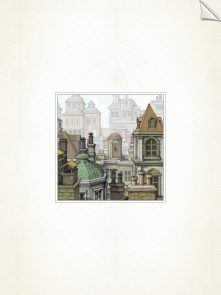Gorogoa felt right to me from the very beginning, from this screen that begins the game:
The picture in the window is lovely, drawn with care; but look at the texture and slightly off-white color of the paper that makes up the boundary of the screen, and look at the untextured white of the window’s boundary strip. This is a game that feels alive, a world where I want to spend time.
Watching the initial scene through that window (and clicking around in it, serving both as a touch of interactivity in what would otherwise be a cut scene and as a gentle tutorial teaching me about changing perspective) did nothing to disabuse me of that notion. And then the one window became four tiles (one filled and three empty), and I got a new interactivity mechanism: it showed a view through a window, and I could move the outside of the window to a second tile.
So that’s the puzzle mechanic: different takes on changing perspective. You can zoom in, you can zoom out, you can pan side to side; you can decompose and recompose, removing outer layers or superimposing them. And you can combine by side-to-side adjacency as well. It’s a mechanic that I haven’t seen before; it’s a mechanic that I enjoy.
Gorogoa’s use of that mechanic turned out to be a good match for me difficulty-wise, too: there were one or two places where it took me a while to figure out how to progess, but I made it past those, and felt like I learned something about the game’s internal logic in the progress. I like Monument Valley quite a bit, but that game decided to go fairly far in the direction of having puzzle solutions be clear; Gorogoa stepped back from that noticeably, but I never ended up needing to head to gamefaqs. It admittedly doesn’t have the sort of puzzle design that supports deep reasoning, admittedly — ultimately, you’re mostly presented with a relatively limited set of potential actions (places to tap, mostly) at any given stage, and trying to figure out what combination of scaling and adjacency will let you progress — but there’s enough there to give you something to think about, and a bit of lateral thinking as well.
More importantly, though, the game grabs my soul. Looking at the basic visual design of the game (the aforementioned textured paper outlines) makes me feel better, looking at the drawings in the game makes me feel better, seeing the hints of the world that the game presents makes me feel better, dancing between scenes and making connections makes me feel better. That’s a rare experience, even outside of games; I should seek it out more.
Post Revisions:
This post has not been revised since publication.

 Posts
Posts